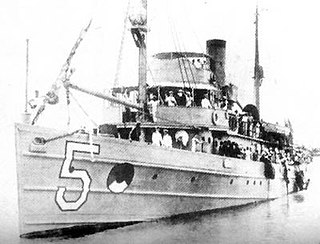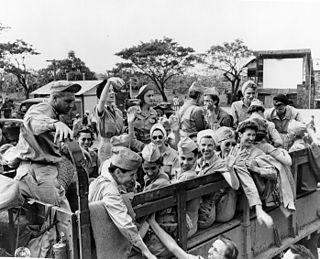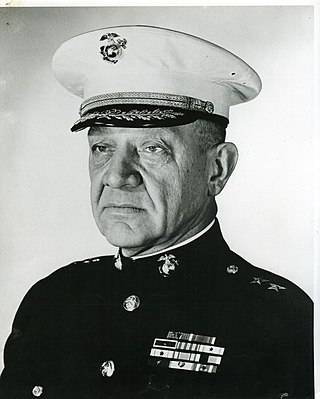
The Bataan Death March was the forcible transfer by the Imperial Japanese Army of 75,000 American and Filipino prisoners of war (POW) from the municipalities of Bagac and Mariveles on the Bataan Peninsula to Camp O'Donnell via San Fernando.

The Philippines campaign, also known as the Battle of the Philippines or the Fall of the Philippines, was the invasion of the Philippines by the Empire of Japan and the defense of the islands by United States and the Philippine Armies during World War II.

The Battle of Corregidor, fought on 5-6 May 1942, was the culmination of the Japanese campaign for the conquest of the Commonwealth of the Philippines during World War II.

Ghost Soldiers: The Epic Account of World War II's Greatest Rescue Mission is a non-fiction book written by Hampton Sides. It is about the World War II Allied prison camp raid at Cabanatuan in the Philippines.

Colonel Thomas F. Breslin (1885–1942) was a civil engineer and a civilian contractor for the United States Army. He was pinned as a Colonel at the outbreak of the Battle of the Philippines and died during the Bataan Death March, the brutal POW march in the aftermath of the Battle of Bataan.

Margaret Elizabeth Doolin "Peggy" Utinsky was an American nurse who worked with the Filipino resistance movement to provide medicine, food, and other items to aid Allied prisoners of war in the Philippines during World War II. She was recognized in 1946 with the Medal of Freedom for her actions.

Camp O'Donnell is a former United States military reservation in the Philippines located on Luzon island in the municipality of Capas in Tarlac. It housed the Philippine Army's newly created 71st Division and after the Americans' return, a United States Army camp. During World War II, the reservation was used as a prisoner-of-war camp for Filipino and American soldiers captured by Japan during its successful invasion of the Philippines. About 60,000 Filipino and 9,000 Americans were housed at the camp. During the few months in 1942 that Camp O'Donnell was used as a prisoner-of-war camp, about 20,000 Filipinos and 1,500 Americans died there of disease, starvation, neglect, and brutality.

Robert Lapham was a reserve lieutenant in the US Army in World War II. He served in the Philippines attached to the 45th Infantry, evaded capture in the spring of 1942, and organized and led one of the largest and most successful guerrilla armies on the central plains of the northern island of Luzon. He was promoted to major by war's end, age 28, and was awarded the Distinguished Service Cross by General Douglas MacArthur. Lapham was the third person, after President Franklin Delano Roosevelt and MacArthur, to receive the Philippine Legion of Honor. Historian Norling says that Laphams's Luzon Guerrilla Army Force (LGAF) was probably the most efficient of the many guerrilla armies on Luzon. The U.S. Guerrilla Affairs Division commended Lapham for having the best-disciplined guerrilla organization.

USS Tanager (AM-5) was an Lapwing-class minesweeper acquired by the U.S. Navy for the dangerous task of removing mines from minefields laid in the water to prevent ships from passing.

USS Finch (AM-9) was a Lapwing-class minesweeper acquired by the U.S. Navy for the dangerous task of removing mines from minefields laid in the water to prevent ships from passing. Finch was named for the finch, and is strictly speaking the only U.S. vessel named for such.

The first USS Pigeon (AM-47/ASR-6) was a Lapwing-class minesweeper of the United States Navy. She was later converted to a submarine rescue ship. She was named for the avian ambassador, the pigeon.
USS Saunter (AM-295) was an Admirable-class minesweeper built for the U.S. Navy during World War II. She was built to clear minefields in offshore waters.

The Angels of Bataan were the members of the United States Army Nurse Corps and the United States Navy Nurse Corps who were stationed in the Philippines at the outset of the Pacific War and served during the Battle of the Philippines (1941–1942). When Bataan and Corregidor fell, 11 navy nurses, 66 army nurses, and 1 nurse-anesthetist were captured and imprisoned in and around Manila. They continued to serve as a nursing unit while prisoners of war. After years of hardship, they were finally liberated in February 1945.
Maryann, sometimes seen as Maryanne or Mary Anne, was a yacht requisitioned and converted by the United States Navy during the defense of the Philippines in World War II and destroyed 5 May 1942 at Corregidor to prevent capture. The yacht was "in service" and not commissioned.

East Island is an island, formerly about 11 acres (45,000 m2) in area, one-half mile (800 m) long and 400 feet (120 m) wide, now greatly reduced in size. It was the second-largest in the French Frigate Shoals, and is one of the Northwestern Hawaiian Islands, approximately 550 miles (890 km) northwest of Honolulu. It was largely washed away in 2018 by the storm surge from Hurricane Walaka. The remaining portion of the island above sea level consists of a sandy strip approximately 150 feet (46 m) long.

Reginald Heber Ridgely Jr. was a United States Marine Corps Lieutenant General. He was taken as a prisoner of war by the Japanese during World War II and was one of the few survivors of the infamous "hellships."
Thomas James Eugene Crotty was a United States Coast Guard lieutenant. He was the first Coast Guardsman to become a prisoner of war since the War of 1812 and the only Coast Guardsman to be captured during World War II and since.

Naval Base Manila, Naval Air Base Manila was a major United States Navy base south of the City of Manila, on Luzon Island in the Philippines. Some of the bases dates back to 1898, the end of the Spanish–American War. Starting in 1938 civilian contractors were used to build new facilities in Manila to prepare for World War II. Work stopped on December 23, 1941, when Manila was declared not defendable against the Empire of Japan southward advance, which took over the city on January 2, 1942, after the US declared it an open city. US Navy construction and repair started in March 1945 with the taking of Manila in the costly Battle of Manila ending on March 2, 1945. Naval Base Manila supported the Pacific War and remained a major US Naval Advance Base until its closure in 1971.















